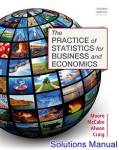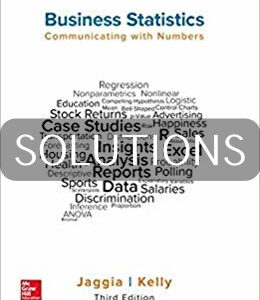Test Bank For The Practice of Statistics for Business and Economics 4th Edition by Moore
Chapter 1
The Demand for Audit and Other Assurance Services
- The Practice of Statistics for Business and Economics Concept Checks
- 8
- To do an audit, there must be information in a verifiable form and some standards (criteria) by which the auditor can evaluate the information. Determining the degree of correspondence between information and established criteria is determining whether a given set of information is in accordance with the established criteria. For an audit of a company’s financial statements the criteria are U.S. generally accepted accounting principles or International Financial Reporting Standards.
- The four primary causes of information risk are remoteness of information, biases and motives of the provider, voluminous data, and the existence of complex exchange transactions.
The three main ways to reduce information risk are:
- User verifies the information.
- User shares the information risk with management.
- Audited financial statements are provided.
- 16
- The three main types of audits are operational audits, compliance audits, and financial statement audits. The table below summarizes the purposes and nature of each type of audit.
Concept Checks (continued)
| OPERATIONAL AUDITS |
COMPLIANCE AUDITS |
AUDITS OF FINANCIAL STATEMENTS |
|
| USERS OF AUDIT REPORT | Management of organization | Authority that established rules, regulations, and procedures, either internal or external to auditee | Different groups for different purposes — many outside entities |
| NATURE | Highly nonstandard; often subjective | Not standardized, but specific and usually objective | Highly standardized |
| PERFORMED BY: CPAs |
Frequently | Occasionally | Almost universally |
| GAO AUDITORS |
Frequently | Frequently | Occasionally |
| IRS AUDITORS |
Never | Universally | Never |
| INTERNAL AUDITORS |
Frequently | Frequently | Frequently* |
* Internal auditors may assist CPAs in the audit of financial statements. Internal auditors may also audit internal financial statements for use by management.
- The major differences in the scope of audit responsibilities for CPAs, GAO auditors, IRS agents, and internal auditors are:
- CPAs perform audits of financial statements prepared using S. GAAP or IFRSin accordance with auditing standards.
- GAO auditors perform compliance or operational audits in order to assure the Congress of the expenditure of public funds in accordance with its directives and the law.
- IRS agents perform compliance audits to enforce the federal tax laws as defined by Congress, interpreted by the courts, and regulated by the IRS.
- Internal auditors perform compliance or operational audits in order to assure management or the board of directors that controls and policies are properly and consistently developed, applied, and




